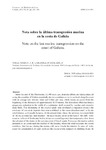Nota sobre la última transgresión marina en la costa de Galicia

View/
Use this link to cite
http://hdl.handle.net/2183/21911Collections
Metadata
Show full item recordTitle
Nota sobre la última transgresión marina en la costa de GaliciaAlternative Title(s)
Note on the last marine transgression on the coast of GaliciaDate
2018Citation
Cadernos do Laboratorio Xeolóxico de Laxe: Revista de xeoloxía galega e do hercínico peninsular, ISSN 0213-4497, Nº 40, 2018, páxs. 229-246
Abstract
[Resumen] Desde el final del Pleistoceno hace 12.700 años hasta el día de hoy se están produciendo efectos dramáticos en toda la orla litoral de la costa de Galicia debidos esencialmente al ascenso del nivel del mar en toda la costa con una velocidad media entre 3mm y 3,5 mm anuales desde el inicio del Holoceno y que se evalúa, aproximadamente, en unos 40,95 metros. El efecto inmediato ha sido una progresiva reducción de la anchura de una plataforma continental cubierta por playas y extensos campos dunares lo que produjo una migración hacia
el continente de los depósitos arenosos movilizados por las olas (playas) y/o por el viento
(dunas). En el momento actual se ha alcanzado prácticamente el límite del avance transgresivo
holoceno al situarse el mar en la base de la costa rocosa acantilada o en su caso frente
a alguna masa de agua dulce (ríos o lagunas costeras) que frena temporalmente el avance de
las dunas o la acumulación de arenas de playa. La acción marina está procediendo a la destrucción
acelerada de las playas donde el viento primero excava sus corredores de tormenta
que luego el mar, durante los temporales, utilizará para invadir el interior del continente.
En las zonas de costa rocosa la acumulación de la arena produce las características dunas
rampantes o trepadoras. En este trabajo se aportan algunos datos de gran interés referidos
a la exhumación de los niveles de antiguos bosques y su fauna asociada, presentes desde el
inicio del Holoceno en la franja litoral, y que ahora, efímeramente, vuelven a ser puestos al
descubierto antes de ser destruidos definitivamente por la acción de las olas. [Abstract] Since the end of the Pleistocene, 12,700 years ago, dramatic effects are taking place all along the coastline of Galicia essentially due to a continuous rise in sea level along the coast with an average rate between 3mm and 3.5mm per year, which means an ascent from the beginning of the Holocene of approximately 40.95 meters. The immediate effect has been a progressive reduction in the width of a continental shelf covered by beaches and extensive dune fields. The shortening of the coastal sandy strip produced a migration towards the continent of the sandy deposits that were mobilized by the waves (beaches) and / or by the wind (dunes), as it usually happens. At the present time, almost the previous maximum limit of the sea advance has been reached. The sea is located either at the base of the cliffy rocky coast or in front of freshwater bodies (rivers or coastal lagoons) that temporarily slow down the advance of the dunes or the accumulation of beach sands. Nowadays the marine action proceeds to an accelerated destruction of the beaches, where the wind excavates the storm corridors, that the sea, during the storms, will use to invade the interior. In areas of rocky coast the accumulation of sand produces the characteristic rampant or climbing dunes. In this paper we provide some very interesting data referring to the exhumation of the levels of ancient forests and associated fauna present at the beginning of the Holocene in the will coastal strip, which now, ephemerally, are again exposed and then be destroyed definitively by the action of the wares
Keywords
Dunas holocenas
Bosque fósil holoceno
Interglacial eemiense
Lagoon costero
Transgresión marina postglacial
Holocene dune
Holocene fossil forest
Eemien interglacial
Coastal lagoon
Postglacial marine transgression
Bosque fósil holoceno
Interglacial eemiense
Lagoon costero
Transgresión marina postglacial
Holocene dune
Holocene fossil forest
Eemien interglacial
Coastal lagoon
Postglacial marine transgression
ISSN
0213-4497





